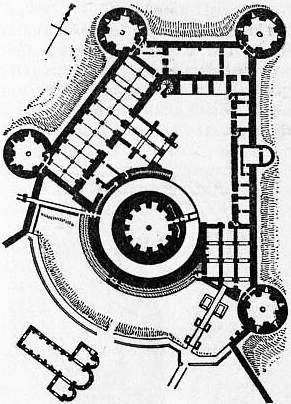gradually sank in importance as the outer “wards” grew stronger. Round instead of rectangular towers were now becoming usual, the finest examples of their employment as keeps being at Conisborough in England and at Coucy in France. Against the relatively feeble siege artillery of the 13th century a well-built fortress was almost proof, but the mines and the battering ram of the attack were more formidable, and it was realized that corners in the stonework of the fortress were more vulnerable than a uniform curved surface. Château Gaillard fell to Philip Augustus in 1204 after a strenuous defence, and the success of the assailants was largely due to the wise and skilful employment of mines. An angle of the noble keep of Rochester was undermined and brought down by John in 1215.

|
Fig. 5.—Krak-des-Chevaliers: View. |
A. High Angle Tower B.B. Smaller Side Towers C.C. D.D. Corner Towers E. Outer Enceinte, or Lower Court F. The Well G.H. Buildings in the Lower Court I. The Moat |
K. Entrance Gate L. The Counterscarp M. The Keep N. The Escarpment O. Postern Tower P. Postern Gate R.R. Parapet Walls |
S. Gate from the Escarpment T.T. Flanking Towers V. Outer Tower X. Connecting Wall Y. The Stockade in the River Z.Z. The Great Ditches |
Fig. 6.—Château Gaillard. | ||
The next development was the extension of the principle of successive lines of defence to form what is called the “concentric” castle, in which each ward was placed wholly within another which enveloped it; places thus built on a flat side (e.g. Caerphilly Castle) became for the first time more formidable than strongholds perched upon rocks and hills such as Château Gaillard, where the more exposed parts indeed possessed many successive lines of defence, but at other points, for want of room, it was impossible to build more than one or, at most, two walls. In these cases, the fall of the inner ward by surprise, escalade, vive force, or even by regular siege (as was sometimes feasible), entailed the fall of the whole castle.
The adoption of the concentric system precluded any such mischance, and thus, even though siege-engines improved during the 13th and 14th centuries, the defence, by the massive strength of the concentric castle in some cases, by natural inaccessibility of position in others, maintained itself superior to the attack during the latter middle ages. Its final fall was due to the introduction of gunpowder as a propellant. “In the 14th century the change begins, in the 15th it is fully developed, in the 16th the feudal fastness has become an anachronism.”
The general adoption of cannon placed in the hands of the central power a force which ruined the baronial fortifications in a few days of firing. The possessors of cannon were usually private individuals of the middle classes, from whom the prince hired the matériel and the technical workmen. A typical case will be found in the history of Brandenburg and Prussia (Carlyle, Frederick the Great, bk. iii. ch. i.), the impregnable castle of Friesack, held by an intractable feudal noble, Dietrich von Quitzow, being reduced in two days by the elector Frederick. I. with “Heavy Peg” (Faule Grete) and other guns hired and borrowed (February 1414). The beginnings of orderly government in Brandenburg thus depended upon the guns, and the taking of Friesack is, in Carlyle’s phrase, “a fact memorable to every Prussian man.” In England, the earl of Warwick in 1464



